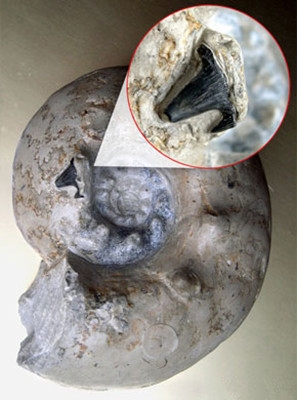(单词翻译:单击)
中英文本
Science and technology
科学技术
Palaeontology
古生物学
Remember the tooth
齿状物所记
A link is made in an ancient ecosystem
古生态系统的一环
WHO ate whom in the food chains of the past is rarely clear.
过去的食物链中谁吃谁的问题很少能明确下来。尽管哪些物种是捕食者,
Though it is obvious which species were predators and which prey,
而哪些物种又是被掠食者显而易见,
the subtle specialisations of feeding habit that allow many types of carnivore to co-exist are rarely preserved in the fossil record.
但是让多种类型的肉食性动物共存的摄食习性的微妙法门却很少在化石记录中保存下来。

Rarely, but not never.
很少,不等于永远都没有。
That is why the recent discovery of a Jurassic ammonite with a shark's tooth embedded in its shell has excited palaeontologists.
这正是最近发现的一枚外壳中嵌有鲨鱼齿状物的侏罗纪鹦鹉螺化石令古生物学家兴奋的原因所在。
The ammonite in question, Orthaspidoceras, a species that thrived 155m years ago,
在1.55亿年前古鹦鹉螺是非常繁盛的物种,
was part of the collection of an amateur who did not realise the significance of what he had found.
讨论中的这枚鹦鹉螺化石是一个业余收藏家的收藏部分,这位收藏家没有意识到它的重大意义。
Romain Vullo of the University of Rennes,
然而,雷恩大学的罗曼?武洛意识到了,
however, did—and he has brought the discovery to the attention of the scientific world in the pages of Naturwissenschaften.
而且他已经借《自然科学》杂志成功地让这个发现受到科学界的注意。
Ammonites were both predators and prey.
古鹦鹉螺既是捕食者又是被掠食者。
They occupied a position in the Mesozoic oceans similar to that of modern squid.
他们在中生代海洋中占有一席之地,类似于现代的鱿鱼。
Like squid, they were swimming tentacled molluscs—a group called the cephalopods.
它们象鱿鱼一样是游动的触手软体动物,这类软体动物被称为头足类动物。
Unlike squid, though, they had protective shells.
不过,它们不象鱿鱼,它们有起保护作用的壳。
These shells were divided internally into gas-filled chambers.
这些壳的内部划分成许多充气室。
The result had neutral buoyancy, allowing the animal to move by jet propulsion.
结果形成中和浮力,使动物能够借助喷气推进移动。
Modern pearly nautiluses, whose relationship to ammonites is much debated, have a similar arrangement.
现代的珍珠鹦鹉螺与古鹦鹉螺的关系备受争议,但它也有类似的结构安排。
What ammonites—or, at least, some of them—ate became clear earlier this year when an X-ray showed a small crustacean in the jaws of a species called Baculites.
古鹦鹉螺以什么为食在今年早些时候终于搞清楚了,X光显示了一个被称为Baculites物种的下颌,证明是小甲壳类动物。
But what ate ammonites has never been shown in such an unambiguous manner.
但是,人们还从来没有以这样一种毫不含糊的方式证明什么动物以古鹦鹉螺为食。
Some ammonite fossils have tooth marks that look as though they were made by huge reptilian predators called mosasaurs.
有些鹦鹉螺化石上的齿痕看起来好像是由巨大的爬虫类捕食者沧龙留下的。
Some appear to have been attacked by the beaks of other cephalopods.
有些看来像是其它头足类动物的嘴袭击过的痕迹。
And some seem to have been bitten by sharks.
有些似乎是被鲨鱼咬伤的。
On top of that, coprolites, as palaeontologists politely describe fossil faeces, have turned up with ammonite shells in them.
除此之外,被古生物学家委婉地形容成粪化石的粪便化石中也找到了古鹦鹉螺的壳。
Based on comparisons with modern evacua, these are probably from sharks.
根据与现代的排泄物相比较,这些化石可能都来自鲨鱼。
But which sharks?
但是是哪种鲨鱼呢?
Dr Vullo's ammonite nails one culprit.
武洛博士的鹦鹉螺化石锁定了一个罪魁祸首。
The tooth belongs to a species called Planohybodus.
这颗齿状物属于一个被称作Planohybodus的物种。
And that is a surprise.
这是一个惊喜。
Those modern sharks that eat shelled animals have robust teeth for crunching through hard exteriors.
以有壳动物为食的那些现代鲨鱼都长着坚固耐用的牙齿,以便咬碎食物坚硬的外壳。
The teeth of Planohybodus, in contrast, were slender and pointed—the sort usually associated with grasping and tearing at flesh.
相反,Planohybodus的牙齿细长而尖锐,就是通常让人联想到抓住并撕咬肉类的那种。
In a modern predator, that would indicate the habit of eating fish.
这可能意味着现代肉食动物有吃鱼的习惯。
That a shark with teeth like this would try to make a meal of an ammonite is, at first sight, odd.
长有这种牙齿的鲨鱼想吃掉古鹦鹉螺,乍一看太奇怪了。
But second thoughts provide a possible explanation.
但再三考虑就会想到一个可能的解释。
Ammonites' manoeuvrability would have depended crucially on their buoyancy control.
古鹦鹉螺的灵活性关键取决于其浮力控制。
Even a small puncture to the shell, which a pointed tooth would be well able to deliver,
即使在其外壳上有一个小小的穿刺,这点尖尖的牙齿驾轻就熟,
would let the water in and cause that control to vanish.
也会让水渗入,造成浮力控制的消失。
Since ammonites could not withdraw entirely into their shells for self-defence,
由于古鹦鹉螺不能完全缩回壳内自卫,那么就剩一个问题了,
it would then just be a question of dragging the creature out of its chamber in order to eat it.
即为了吃掉它而把这种动物从壳腔内拽出来。
And for that, sharp, pointed teeth are ideal.
对于这点,锐利的尖尖牙齿就十分理想了。
词语解释
1.ecosystem n.生态系统
Water is the core of a healthy ecosystem.
水是维持生态系统良性循环的根本。
2.predator n.食肉动物;掠夺者
Young birds are very vulnerable to predators.
幼小的鸟易受食肉动物伤害。
3.prey n.牺牲者;被掠食者
She was easy prey for dishonest salesmen.
她很容易地让奸商敲了竹杠。
4.specialisation n.专门;专业化
Innovation and specialisation are more important.
创新和专业化更为重要。
5.preserve v.保护;保存;保持
It is highly important to preserve the environment.
保护自然环境至关重要。


